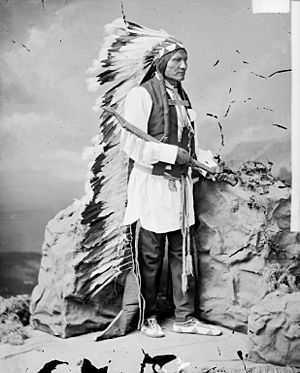He Dog facts for kids
Quick facts for kids
He Dog
|
|
|---|---|
| Šúŋka Bloká | |

Portrait by Charles M. Bell, taken in Washington, D.C., Oct. 1877.
|
|
| Oglala, Lakota leader | |
| Personal details | |
| Born | c. 1840 |
| Died | 1936 (aged 95-96) Pine Ridge Indian Reservation, South Dakota, United States |
He Dog (Lakota: Šúŋka Bloká) was an important leader of the Oglala Lakota people. He was born around 1840 and lived until 1936. He Dog was a close friend and ally of the famous warrior Crazy Horse. They fought together during the Great Sioux War of 1876-77.
Contents
He Dog's Early Life and Family
He Dog was born in the spring of 1840. His birthplace was near the Black Hills, by the headwaters of the Cheyenne River. His father was a respected leader named Black Stone. His mother, Blue Day, was the sister of the well-known chief Red Cloud. He Dog's youngest brother was Grant Short Bull.
By the 1860s, He Dog and his brothers had formed their own small group. This group was called the Cankahuhan, or the Soreback Band. They were closely connected to Red Cloud's Bad Face band of Oglala.
Fighting in the Great Sioux War
He Dog and his relatives were key figures in the Great Sioux War of 1876-77. This war began because the U.S. government wanted the Lakota to give up the Black Hills. In January 1876, the President sent a message to the northern Lakota bands. It told them to come to the agencies or face the army.
He Dog's Soreback band was camped on the Tongue River when they received this message. His brother, Short Bull, later remembered that most northern Oglala planned to go to the Red Cloud Agency. They wanted to go in the spring, after their last big buffalo hunt.
The Powder River Attack
In March 1876, He Dog married a young woman named Rock. He and part of his band briefly stayed with the Northern Cheyenne. They were camped on the Powder River in Wyoming Territory. On March 17, 1876, soldiers led by Colonel Joseph J. Reynolds attacked their camp.
Short Bull later said this attack changed everything. He believed that if the attack had not happened, they would have gone to the agency. He felt there would have been no Sioux War.
Major Battles and Surrender
During the summer of 1876, He Dog fought in important battles. He was at the Battle of the Rosebud and the famous Battle of the Little Bighorn. He also fought at Slim Buttes in September 1876. In January 1877, he was at Wolf Mountain.
He Dog finally surrendered at the Red Cloud Agency in May 1877. He surrendered alongside Crazy Horse. After Crazy Horse was killed, He Dog traveled to Washington, D.C. He went as a delegate to meet the President.
Life After the War
He Dog and other members of the Soreback Band left the Red Cloud Agency. This happened after it was moved to the Missouri River in the winter of 1877-78. They crossed into Canada and joined Sitting Bull in exile for two years.
Most of the northern Oglala surrendered at Fort Keogh in 1880. They were then moved to the Standing Rock Agency in 1881. Finally, in the spring of 1882, He Dog and all the northern Oglala moved to the Pine Ridge Indian Reservation. There, they joined their relatives.
He Dog lived the rest of his life on the Pine Ridge Reservation. He became a respected Indian judge. Later in his life, many historians interviewed him. These included Walter Mason Camp, Eleanor Hinman, and Mari Sandoz. He Dog passed away in 1936, at the age of 95 or 96.
See also
 In Spanish: Sunka Bloka para niños
In Spanish: Sunka Bloka para niños

